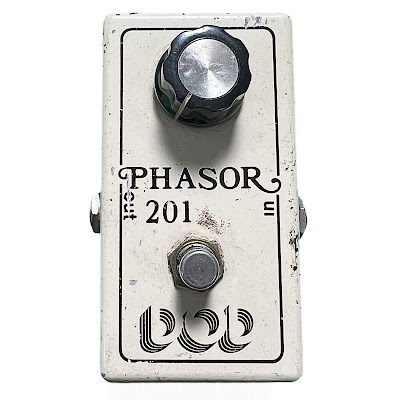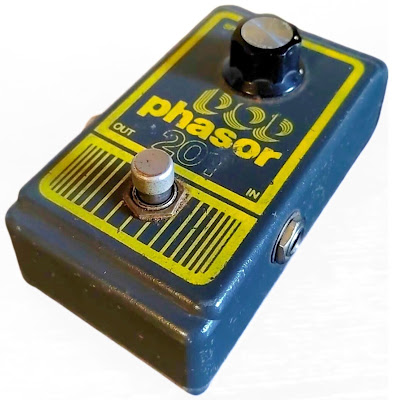So as always, we seek to discover more and more. And if you happen to have any additional information about the Baby Fuzz line, please feel free to reach out via Email or Instagram
Thursday, July 31, 2025
Baby Fuzz / Distor Wha (70's France)
So as always, we seek to discover more and more. And if you happen to have any additional information about the Baby Fuzz line, please feel free to reach out via Email or Instagram
Monday, July 28, 2025
Garen Fuzz - Chambre De Distorsion (1969)
Garen Electronic Music Instruments MFG. was mostly known as an amplifier brand, based in Paris and started by Jean Guen around 1958. And I would go into more depth about their history, but it's so well laid out in this website run by Guen's own grandson, that I highly recommend going through all of their awesome photos and detailed info if you really want to go extra deep. But to skip ahead for the sake of this post; with the rise in popularity of Rock & Roll in France, Garen decided it was time to capitalize on the moment with a new line of amps and their own take on both reverb units and the new 'hip' fuzz sound sweeping the nation.
So in 1966 the Garen Distortion was born! Coming in a super sleek, polished chrome wedge enclosure with a cool 3-way tone switch, it stood out among the onslaught of foreign fuzz pedals invading Europe during the 60s. With an unexpectedly simple design, based more on basic transistor theory than on any specific fuzz pedal, the Garen Distortion was something unique that proud French players could call their own.
Built like a tank with the engineering precision of a NASA rocket, it also stood wayyyyyy out in terms of quality for the 1960s. Everything from the wiring to the battery door was constructed with an attention to detail rarely seen in the vintage effects world.
It might not translate over photos just how well these are made, but trust me! These things are solid, and ready to last another 50+ years.
The circuit itself runs off three germanium transistors, and while the majority used are unlabeled, at least one unit has surfaced with AC182's.
 |
| photo by: Rafmax |
Even though most of the pedals we write about here are steeped in mystery, the Garen fuzz has been pleasantly easy to research (and I greatly appreciate that!). So although we still don't know exactly how long they were being made, how many were made, and if they actually appear on any of those 60s French fuzz records, I can appreciate that we're much further along than we typically are by then end of these posts.

Thanks for reading,
Saturday, July 19, 2025
Early Shin-ei Advertisements
But unlike the vast majority of US pedal manufacturers that were relatively easy to research, the more layers I peeled, the further away I got from learning who was behind Shin-ei and what their actual connection to pedal history was. To this date, we (well, I ) still don't know any names of anyone who worked for what has to have been a huge factory (and one that ran for at least a decade). Nor do we know if they actually designed any of the effects they built. Nor do we know something as simple as how a foreign brand, like Apollo, would have found out about Shin-ei and hired them to produce gear with their logo attached...
So today we continue with what I've been able to find over the past couple of years, with a little help from some friends over in Japan. We have 3 advertisements (all from 1969, I believe) that show Shin-ei in a moment of transition, from "Shin-ei, the manufacturer of microphones and pickups", to "Shin-ei, the manufacturer of guitar effects and more". As far as I know, none of these have been available on the internet until now :)
Tuesday, July 1, 2025
DOD 201 Phasor - The First 3 Years
So today we're going to look at the pedal that was born right out of those original big box Phasors and its exponential evolution through the first 3 years of production...
At the beginning of 1977 DOD introduced a new, scaled-down line of effects. It was called the "200 Series" and featured the now infamous "Bud Box" enclosures. They were the first DOD pedals with a smaller footprint and an attempt from the brand to follow the trends of the time.
In keeping with tradition, the first effect they released was the 201 Phasor. It was a completely redesigned circuit from their previous two phase shifters, taking cues instead from the MXR Phase 45.
Like all of the pedals from that series it featured an off-white finish, 3-D brand logo, and that fancy old westy font.
It's believed that these were built for just a few months, making them quite rare and hard to track down nowadays. So if you find one (or currently own one) let me know! :)
In the Fall of 1977 DOD was ready to release their brand new updated "200 series" pedals. Following legal threats from MXR, they ditched the Bud Box enclosures and created their own unique sand casted units.
Again, the first effect they would choose as the introduction to this new series would be their 201 Phasor. Now cloaked in grey paint with bright yellow graphics and that big bold 3D brand logo, DOD would unknowingly release what would become one of the most iconic guitar pedal lines of all time.
The circuit remained roughly unchanged, with the biggest difference being a new larger PCB, giving the parts room to breath without all the constraints of a Bud Box enclosure.
In early 1978 DOD again changed the look of their pedals, but this time it was purely graphical. Along with the 250 Overdrive Preamp and the 280 Compressor, the new 201 Phasor would shift to a smaller DOD brand logo and a thinner font.
The pedal was otherwise identical inside and out. And this would be the last era of DOD effects that were battery powered only (note the lack of a 9v jack on the side of this and the previous two versions).
Not quite as rare as the two models above, but this version is still considered somewhat of a "hen's tooth". Amazingly though, it's often overlooked as it's easy to miss the no-power jack.
Toward the latter half of 1978 DOD again revised their 200 Series effects, giving the customers what they wanted... a power jack!
Visually this version looks almost identical to the previous one, and it is, except the added jack on the side above the output. Inside, as is with the 250 and 280, there is an update to the circuit that simply accommodates the new wall power (affecting the tone slightly, but noticeably).
These are fairly common to find on resale sites, and to the point that if you can't find one, just be patient... you will.
The final version of the gray 201 Phasor came out in 1979, and on a technical level, is the same as the previous version (although you will find differences in component brands, just like all DOD pedals).
The biggest difference here is the graphics were changed to highlight the various jacks; "Out", "In", and the brand new "PWR." were placed within the borderlines themselves. This again is an updated feature you will see on most of the 200 Series effects from this era.
These are the most common gray 201 Phasors you will come across. And although I didn't get into serial numbers, this version has the widest range.
From here, DOD would continue to expand their phase shifting repertoire, and go on to release the 401 Phasor, the 490 Phasor, and the 201 Phasor in yellow all within a year of each other. And while the gray 201's lifespan was relatively short, it serves as the perfect example of a young company pushing forward, figuring it out as they went along, and just making it work!
So if you have any additional details on the history of DOD, or if you happen to have one of the first two Phasors discussed above, please feel free to reach out to me via Email or Instagram, I'd love to hear about them.
thanks for reading,-ed





























